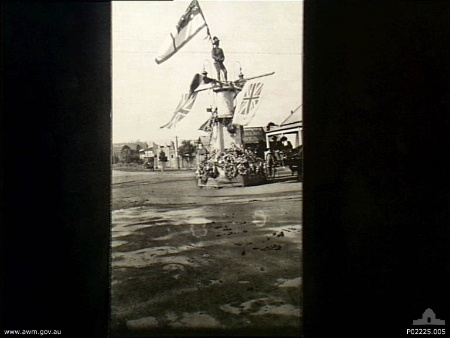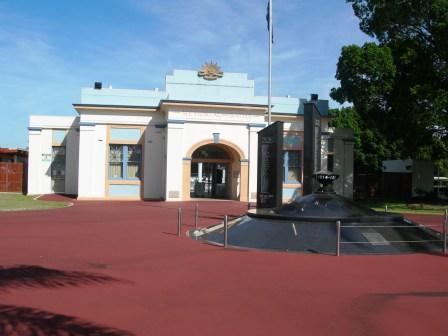This weeks Memorial Way features the north coast city of Lismore, New South Wales. The National Archives of Australia (NAA) Mapping Our Anzacs shows that 3,088 men enlisted at Lismore for the AIF during the Great War.
The Lismore Memorial Baths were built to honour 183 of these local men who lost their lives during the conflict.
The Memorial Baths are located in War Memorial Park on Molesworth Street at GPS 28°48’39.14″S, 153°16’26.44″E. In front of the entry to the baths is the Second World War Memorial. Further along the park are the Boer War Memorial and Vietnam Memorial.
The Northern Star newspaper in its insert ICON Landmarks in January 2009 described the memorial as: an unusual way of honouring the fallen from the Great War. They were designed by Lismore architect Colonel F.J. Board….. Completed in 1928, the baths have an unusual entrance, which some say is modelled on the Menin Gate, the Memorial to the Missing at Ypres Belgium.
The foundation stone of the memorial was laid by Lt. General Sir Harry Chauvel CCMG – KGB on 1st October 1927. The baths were opened by NSW Minister for Local Government and Gallipoli veteran Colonel M.F. Bruxner. Colonel Bruxner said at the opening ceremony fallen soldiers would have approved of swimming baths, ‘more than anything else you could erect’.
The slideshow below contains photos of the memorials in War Memorial Park at Lismore. The slideshow can be viewed full screen by clicking on the projector screen icon in the bottom right corner. To return to the article simply press the escape key.
[slideshare id=1179750&doc=lismorewarmemorials-090322052624-phpapp02]
Scroll down for more information…….
Before the erection of the Memorial Baths the Lismore Boer War Memorial was used as the site of commemoration. The photo below from the Australian War Memorial Collection shows the NSW Lancer atop the Boer War Memorial decorated with the flags of Australia, Britain and France for victory celebrations held in the town on 19 July 1919.
 Source: Australian War Memorial Collection
Source: Australian War Memorial Collection
The Northern Star article goes on to say: Public funds for construction [of the baths] were raised by holding events such as a street carnival and using the slogan: ‘Be a Brick, Buy a brick for Lismore’s Memorial Baths’. Dressing sheds were added in 1929 and by January 1930 a second level housed the Lismore Soldier’s Club.
The slide show below records the faces of 31 of the 183 men whose names are recorded on the Honour Roll of the Memorial Baths, including Private Patrick Bugden VC. For more information on Private Bugden see Briefing Room No. 6.
[slideshare id=1177286&doc=lismoresoldiers-090321052320-phpapp01]
The slideshow can be viewed full screen by clicking on the projector screen icon in the bottom right corner. To return to the article simply press the escape key.
The current State Member for Lismore, Thomas George, has produced an Anzac booklet, which is available on line by clicking here. This document also contains an article on Private Bugden V.C. as well as Corporal Stratford – a Lismore soldier in the 9th Battalion claimed by witnesses to be the first ashore at Gallipoli and killed during the landing(C. E. W. Bean, official historian, concluded that the first ashore was possibly Lieutenant Duncan Chapman of the 9th Battalion but possibly both were in the same boat).
*****
The Families and Friends of the First AIF thanks the Australian, UK and French governments for affording Australian and British soldiers – presently buried in mass graves at Pheasant Wood – dignified individual reburials in a new CWGC cemetery at Fromelles, and applauds Minister Snowdon and his British counterpart, Parliamentary Under-Secretary of State for Defence and Minister for Veterans, Kevan Jones MP, for their joint decision to DNA test the remains at exhumation and use every reasonable method to attempt identification of each soldier.


